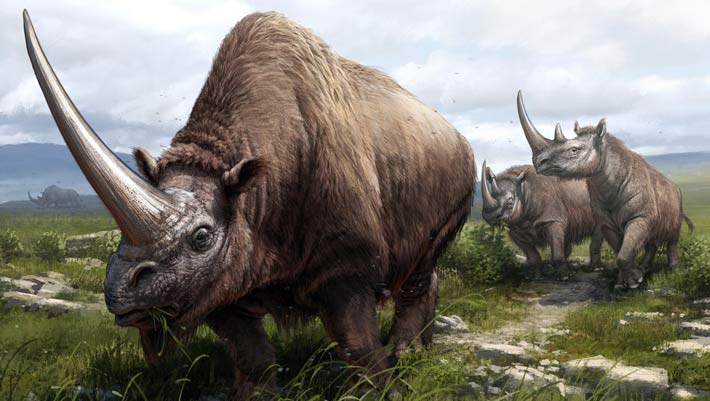Paleontologists have retrieved ancient enamel protein sequences from a fossilized tooth of Epiaceratherium sp., a rhinocerotid that lived in Canada’s High Arctic between 24 and 21 million years ago (Early Miocene). The recovered sequences allowed the researchers to determine that this ancient rhino diverged from other rhinocerotids during the Middle Eocene-Oligocene epoch, around 41-25 million years ago. The new data also shed new light on the divergence between the two main subfamilies of rhinos, Elasmotheriinae and Rhinocerotinae, suggesting a more recent split in the Oligocene, around 34-22 million years ago, than shown previously through bone analysis.
A paleoartist’s reconstruction of the three extinct rhino species: in the foreground is a Siberian unicorn (Elasmotherium sibiricum), and close behind are two Merck’s rhinoceroses (Stephanorhinus kirchbergensis); in the far background is a woolly rhinoceros (Coelodonta antiquitatis). Image credit: Beth Zaiken.
Dr. Marc Dickinson from the University of York and colleagues analyzed a tooth of Epiaceratherium sp. using a technique known as chiral amino acid analysis to gain a clearer understanding of how the proteins within it had been preserved.
By measuring the extent of protein degradation and comparing it to previously analyzed rhino material, they were able to confirm that the amino acids were original to the tooth and not the result of later contamination.
“It is phenomenal that these tools are enabling us to explore further and further back in time,” Dr. Dickinson said.
“Building on our knowledge of ancient proteins, we can now start asking fascinating new questions about the evolution of ancient life on our planet.”
The rhino is of particular interest as it is now classified as an endangered species, and so understanding its deep-time evolutionary history, allows us to gain vital insights into how past environmental changes and extinctions shaped the diversity we see today.
To date, scientists have relied on the shape and structure of fossils or, more recently, ancient DNA (aDNA) to piece together the evolutionary history of long-extinct species.
However, aDNA rarely survives beyond 1 million years, limiting its utility for understanding deep evolutionary past.
While ancient proteins have been found in fossils from the Middle-Late Miocene — roughly the last 10 million years — obtaining sequences detailed enough for robust reconstructions of evolutionary relationships was previously limited to samples no older than four million years.
The new study significantly expands that window, demonstrating the potential of proteins to persist over vast geological timescales under the right conditions.
“Successful analysis of ancient proteins from such an old sample gives a fresh perspective to scientists around the globe who already have incredible fossils in their collections,” said Dr. Fazeelah Munir, also from the University of York.
“This important fossil helps us to understand our ancient past.”
The results were published this week in the journal Nature.
_____
R.S. Paterson et al. Phylogenetically informative proteins from an Early Miocene rhinocerotid. Nature, published online July 9, 2025; doi: 10.1038/s41586-025-09231-4
